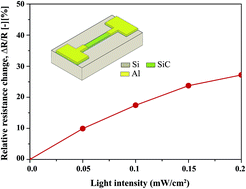3C–SiC on glass: an ideal platform for temperature sensors under visible light illumination†
Abstract
This letter reports on cubic silicon carbide (3C–SiC) transferred on a glass substrate as an ideal platform for thermoresistive sensors which can be used for in situ temperature measurement during optical analysis. The transfer of SiC onto an insulating substrate prevents current leakage through the SiC/Si junction, which is significantly influenced by visible light. Experimental data shows that the 3C–SiC on glass based sensor possesses a large temperature coefficient of resistance (TCR) of up to −7508 ppm K−1, which is about 10 times larger than that of highly doped Si. Moreover, the 3C–SiC based temperature sensor also outperforms low doped Si in terms of stability against visible light. These results indicate that 3C–SiC on glass could be a good thermoresistive sensor to measure the temperature of cells during optical investigations.



 Please wait while we load your content...
Please wait while we load your content...